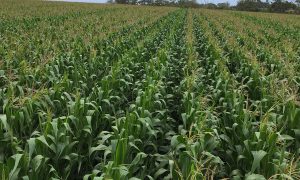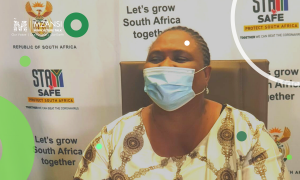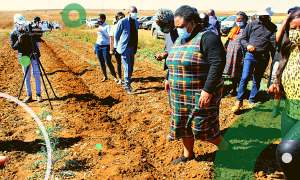Indigenous Animal Genetic Resources (AnGR), constitute the largest reservoir of genetic diversity, and their improvement and conservation have great social, economic, and cultural impacts especially in the plight of climate change and high unemployment rates. In addition, Covid-19 has added more pressure to the poor and marginalized communities across the country where food security is more of an immediate threat to the livelihoods of millions of households than the pandemic.
The response to the negative impacts of the pandemic to the economic viability of the livestock sector has now become more vital and pressing than before. Strategizing to find solutions for improved food security and household income sustainability require collaborative efforts from various stakeholders from policymakers, government, funders and the research community to be successful.
In 2015, the Directorate Genetic Resources of the Department of Agriculture, Land Reform and Rural Development (DALRRD) developed a National Plan (NP) for conservation and sustainable use of farm animal genetic resources (FAnGR) of South Africa adopted. This was in response to the FAOs’ Global Plan of Action for Animal Genetic Resources and the 2030 Agenda for Sustainable Development of the United Nations.
The NP has four Strategic Priority Areas namely: Characterization, Sustainable use, Conservation and Policy. Through this National Plan, numerous projects have since been funded through the Directorate focusing on conservation and improvement of indigenous breeds and non-descript ecotype populations. Among these funded projects, is the Community-Based Breeding Programs (CBBPs) of indigenous goats in rural areas across major goat producing provinces. CBBPs present a viable option for a low-input smallholder production system where flock sizes are small, animals are reared communally and high-investment animal breeding strategies are not feasible.
Such programs have been reported with success for locally adapted livestock species in countries such as Argentina, Ethiopia, Malawi, Mexico, Liberia, Uganda and other Southern African countries. In these countries, CBBPs has been reported to increase productivity and income of resource-constrained farmers by providing access to improved animals that respond well to current feeding and management, while targeting local market opportunities.
In South Africa, conservation and sustainable utilization of indigenous goats are key issues for resource-poor farming communities that rely on them. It is because these animals have a history of adaptation to local harsh environmental conditions, which translates into unique phenotypic and genetic diversities as well as their ability to thrive in a low input production environment. This makes them suitable for supporting rural low-income households, therefore hold hope for rural development and sustainable resource
. The major benefit of CBBPs is the potential to not only improve productivity but also preserve the animal’s genetic diversity and their unique adaptability traits as the production systems remain unchanged. The model of crossbreeding with government donated less adaptable improved breeds has led to a genetic dilution of the locally adapted population and continues to undermine their genetic potential and market acceptance. In addition, the model of conservation at research stations or government farms have been proposed as a viable solution for genetic improvement for decades. While their benefits cannot be taken away from them, the limitation is the change In the production system and the potential loss of fitness traits.
Successful CBBPs have been paired with a technical expert from various stakeholders in the production value chain as well as researchers. Farmer-scientist interactions to evaluate different breeding options and thus facilitate informed decisions on animal management based on the farmer’s needs and the market have been seen as a key element of the CBBP approach. They also allow for phenotypic and genetic characterisation of local populations within the village production system as well as the production and adaptation traits, which normally not be considered by previous national projects.
This will, in turn, enable the capture of these characteristics and other genetic merits to be documented at the community level and better monitor the national and regional livestock sectors and formulate adequate development strategies and policies. In addition, they offer opportunities for the formation of community-level breeding societies for ecotype populations across the different agro-ecological regions.
In the scope of CBBP, genomics approaches provide new tools for supporting breeding strategies where it can be used for parentage verification, confirm breed composition, monitor inbreeding as well as a selection of production, adaptation and farmer preferred traits in these ecotype populations. Although research on indigenous goats has entered a new era since the advent of genetics and genomics; the genetic improvement of goats has been slow in comparison to other livestock species.
Genomic-assisted breeding applies knowledge of genetic variations found in the genome and their relationship with production traits or phenotypes (e.g., coat colour, bodyweight, etc.) in selection for improved productivity (e.g., disease resistance, high-quality meat and carcass traits, milk yield, etc.). The application of quantitative genetic theories, statistical approaches and organized breeding practices can result in rapid gains in production traits without undermining the genetic merits of the animal resource.
The cost of whole-genome sequence data or the commercially available SNP array has not been justified for selection programs especially in smallholder communal production systems. For genomics to be optimally integrated into breeding programs, there is a need to develop more customized and less costly SNP panels that will be useful in selecting traits important to local production.
It has also been proposed that CBBPs may perform much better with the practical application of modern optimal recording technologies such as digital data management platforms. Such platforms can solve problems resulting from the manual recording of data (which is what is currently being done), including incomplete or unavailable records. The increased use of smart mobile phones in Africa, even in the most remote rural areas, provides an opportunity to develop smart livestock production innovations to improve the livelihoods of small scale farmers.
Stakeholders such as the Agricultural Research Council and numerous institutions of higher education through funding bodies such as the government have made great strides in the improvement and conservation of indigenous livestock which must be applauded. Lessons learnt include the direct benefit of farmers from these research efforts to promote an economically viable production system and integrate their meat and products into formal markets and value chains in South Africa.
By Dr Khanyisile Hadebe (Agricultural Research Council, Biotechnology Platform)




















